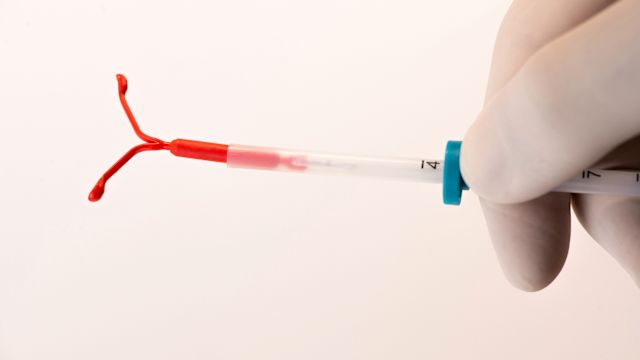Updated on March 25, 2025
An intrauterine device (IUD) is a form of long-acting reversible contraception. It is the third most commonly used contraceptive in the United States. More than 10 percent of the female population in the U.S. who are between the ages of 15 and 49 years old have an IUD.
What exactly is an IUD?
An IUD is a small, plastic, flexible, T-shaped device that is inserted into the uterus. There are multiple IUDs available, which fall into two general categories—hormonal IUDs and copper IUDs:
- Hormonal IUDs release levonorgestrel, a type of progestin (a synthetic version of the hormone progesterone). Levonorgestrel thickens mucus in the cervix (the lower part of the uterus) to prevent sperm from reaching an egg. It also thins endometrium, the lining of the uterus. Depending on the dosage of levonorgestrel being released, a hormonal IUD may also suppress ovulation (an egg being released from the ovaries).
- Copper IUDs trigger an inflammatory response in the lining of the uterus. This prevents pregnancy by making it difficult for sperm to move around and survive.
What are the advantages of an IUD?
Both hormonal and copper IUDs have a high rate of patient satisfaction. Some of the advantages of this method of contraception include:
- IUDs provide long-term contraception. Hormonal IUDs last between 3 and 8 years, depending on the specific product being used. Copper IUDs last up to 12 years, depending on the product being used.
- IUDs are fully reversible. If a person no longer wants to use an IUD—for example, if they would like to become pregnant—it can be removed by a healthcare provider.
- IUDs are effective. An IUD has a failure rate of less than 1 percent. This means that for every 100 people using an IUD in a given year, fewer than one will have an unplanned pregnancy. For comparison, the pill has a failure rate of around 7 percent when accounting for user error.
- IUDs are convenient. An IUD insertion is a one-time procedure that provides effective contraception for years. There are no prescriptions to fill, patches to apply, pills to remember to take, or anything that needs to be inserted or applied before sex. There is virtually no risk of user error.
Why do some people get pregnant when using an IUD?
Mentioned in the last point, user error with an IUD is minimal, but minimal is not zero. Some hormonal IUDs require seven days in order to take effect, which means a person will not have full protection against pregnancy for the first seven days following the insertion, and a pregnancy can occur during this time—this is something to check with your healthcare provider. Pregnancy is also more likely to occur if an IUD is used beyond its expiration date.
There is also a chance of user error from the healthcare provider placing the IUD—if the IUD is not placed correctly, a pregnancy is more likely to occur. As a person getting an IUD, you can minimize this risk by working with a healthcare provider who is experienced in inserting IUDs.
Expulsions (an IUD moving out of the uterus on its own) and perforation (where the IUD pierces the wall of the uterus) can also occur, but the risk is considered low. If an expulsion occurs, an IUD no longer protects against pregnancy. Risk factors and signs of expulsion and perforation are another topic that should be discussed with a healthcare provider.
What are the disadvantages of an IUD?
It’s important to remember that IUDs do not protect against sexually transmitted infections (STIs). However, an IUD can be used along with condoms, which will protect against STIs.
Like any medical product or procedure, there is a risk of adverse effects. These should be discussed with a healthcare provider before an IUD is inserted:
- Risk of bacterial infection. This can occur if bacteria enter the body during the insertion process. Infection symptoms are most likely to occur in the first three weeks after an insertion. A cleansing solution will be used during the insertion procedure to prevent infection.
- Risk of pregnancy complications. Complications are more likely to occur if a person becomes pregnant with an IUD in place. This includes a higher risk of ectopic pregnancy (implantation outside the womb).
- Disruptions to menstrual cycle. Hormonal IUDs can cause irregular or missed periods and often reduce menstrual symptoms (some may be used to treat heavy menstrual bleeding). Copper IUDs can increase the severity of cramps and menstrual bleeding, but these symptoms often improve within a few months.
IUDs are considered safe, and there are precautions that will be taken to prevent these complications. If you have a concern, the best thing to do is talk about it with your healthcare provider.
Will an IUD insertion be painful?
Pain during and after an IUD insertion is a topic that is often discussed. Different people have different experiences with pain, with some reporting moderate-to-severe pain and others reporting minimal pain and discomfort. There is also a risk of vasovagal symptoms during IUD insertion. This is an overreaction by the nervous system that causes a drop in blood pressure and heart rate, causing a person to feel faint. This is usually harmless.
The possibility of pain is another important topic to discuss with your healthcare provider. There are several steps and strategies you and your healthcare provider can use to avoid, reduce, and minimize pain during an IUD insertion and afterward.




